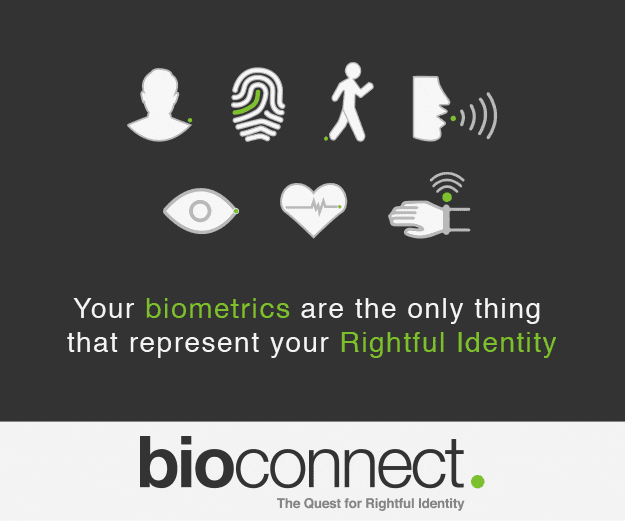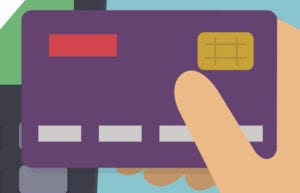After the mobile wallet boom, it looked like biometrics were going to kill the credit card via the mobile wallet. By collecting all of a user’s accounts into a single device, protecting the data with biometrics, and adding the contactless convenience of NFC or MST technology – the latter which enabled tap-style convenience even on old magstripe card readers — the likes of Apple Pay, Samsung Pay and Android Pay brought serious competition to the payments arena.
In the wake of the mobile wallet, further innovations emerged and popularized, inevitably leading to the logical convenience endpoint: naked payments – solutions that allow consumers to pay with nothing but their bodies. Convenience, enabled by security, has led to the ultimate simplification of payments.
But the credit card isn’t done for, yet
 The race for biometric credit cards was on in 2017, and as we approach year’s end, it’s beginning to look like 2018 will see the fingerprint-powered comeback of plastic payments. Recent research from ABI predicts massive growth for the biometric payment card market which will see a 400 percent CAGR through 2022.
The race for biometric credit cards was on in 2017, and as we approach year’s end, it’s beginning to look like 2018 will see the fingerprint-powered comeback of plastic payments. Recent research from ABI predicts massive growth for the biometric payment card market which will see a 400 percent CAGR through 2022.
While the predicted credit card renaissance is dramatic, it’s not much of a surprise. Biometric payment cards satisfy all the requirements for a popular modern FinTech solution.
Familiarity
 Biometrics are proof that history, education, and public perception play a major role in mainstream adoption of new technology. Stigma left over from over a century of associating fingerprints with law enforcement still drives many of the anti-biometrics sentiments that circulate whenever a new modality is on the verge of going mainstream. Thankfully, mobile device proliferation of fingerprints have familiarized consumers with biometrics to the point where they no longer seem exotic or futuristic or dangerous. Indeed, the fingerprint sensor has become so much of a standard feature on smartphones that the most notable detail about Apple’s new iPhone X is the technology’s absence.
Biometrics are proof that history, education, and public perception play a major role in mainstream adoption of new technology. Stigma left over from over a century of associating fingerprints with law enforcement still drives many of the anti-biometrics sentiments that circulate whenever a new modality is on the verge of going mainstream. Thankfully, mobile device proliferation of fingerprints have familiarized consumers with biometrics to the point where they no longer seem exotic or futuristic or dangerous. Indeed, the fingerprint sensor has become so much of a standard feature on smartphones that the most notable detail about Apple’s new iPhone X is the technology’s absence.
Biometric ubiquity only compounds the next gen credit card’s familiarity, which is already its greatest consumer market strength. If you are among the world’s financially active population, chances are you were using credit cards before mobile wallets. In fact, owning a credit card is a prerequisite for mobile wallet activation (you have to link your accounts to Apple Pay, Samsung Pay, et al). Therefore the paradigm shift for paying with a biometric credit card is a much smaller leap than paying with your phone. Paying with a card just feels normal.
Convenience
 The credit card and the mobile wallet are locked in a war of convenience. And as it stands, NFC tap cards are still faster. The addition of a biometric sensor, which replaces the need for a PIN on expensive payments, simply ensures that convenience remains part of the credit card experience no matter what you’re buying. Lighter, smaller, and pre-loaded with your account information, a biometric credit card is simply a more secure and more versatile version of what’s already the easiest way to pay.
The credit card and the mobile wallet are locked in a war of convenience. And as it stands, NFC tap cards are still faster. The addition of a biometric sensor, which replaces the need for a PIN on expensive payments, simply ensures that convenience remains part of the credit card experience no matter what you’re buying. Lighter, smaller, and pre-loaded with your account information, a biometric credit card is simply a more secure and more versatile version of what’s already the easiest way to pay.
Where the biometric credit card loses out to the mobile wallet is in the online realm, where paying with the touch of a fingerprint will win out over reentering credit card information any day of the week. And as mobility begins to enable naked payments – as it has already in India with Aadhaar Pay – time will tell how long the card can keep its competitive edge of convenience. But for the time being, a fingerprint scanning card promises to the be fastest way to pay in person.
Sympathy for the Smart Card

There is a market sympathy at work that is pushing the biometric credit card into existence. While the payment card industry itself faced direct competition from the rise of the mobile wallets, recent design innovations in the world of smartphones have dampened the once explosive fingerprint sensor market. In one another, the payment card and fingerprint sensor manufacturers have found powerful allies.
While fiscal updates from fingerprint biometrics companies all year have been cooling in response to multiple developments on the mobile device front, one area has maintained activity and excitement all year: payment cards. Mastercard has conducted successful trials of the technology around the globe, sensor manufacturers have shipped order after order to serve this emerging market, and partnerships with some of the biggest players in each respective industry are ensuring the biometric credit card will happen.
While skepticism remains regarding the longevity of a biometric payment card solution, one thing is for certain: the biometric credit card is coming, and it stands to change consumers’ relationship to money, identity, security and convenience.
*
Stay posted to FindBiometrics throughout November as we continue to bring you featured content for Financial Biometrics Month.
Financial Biometrics Month 2017 is made possible by our sponsors BioConnect and BioCatch.
—
November 9, 2017 – by Peter B. Counter


Follow Us